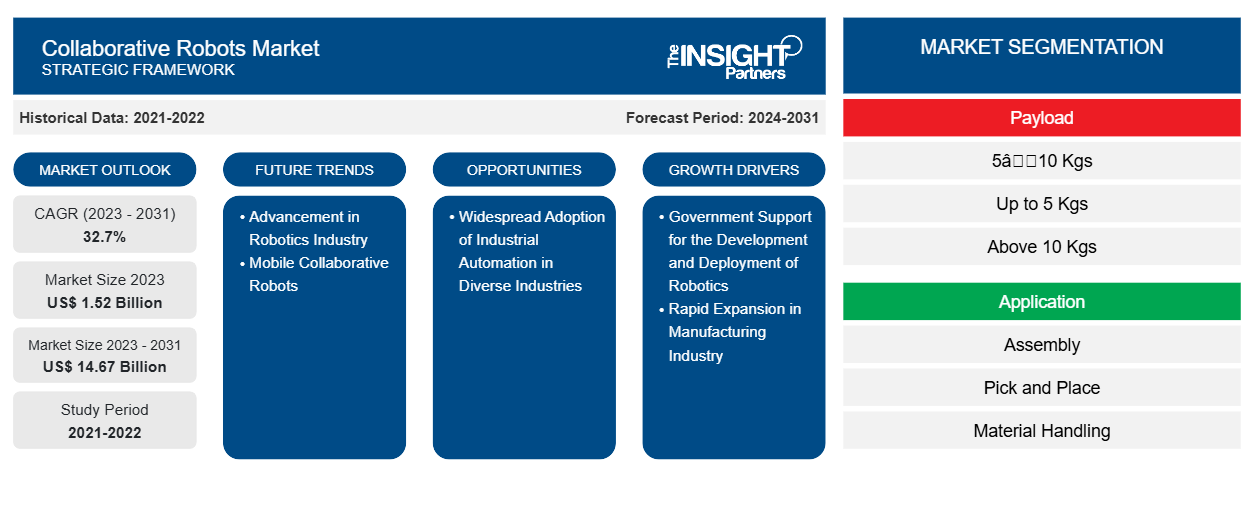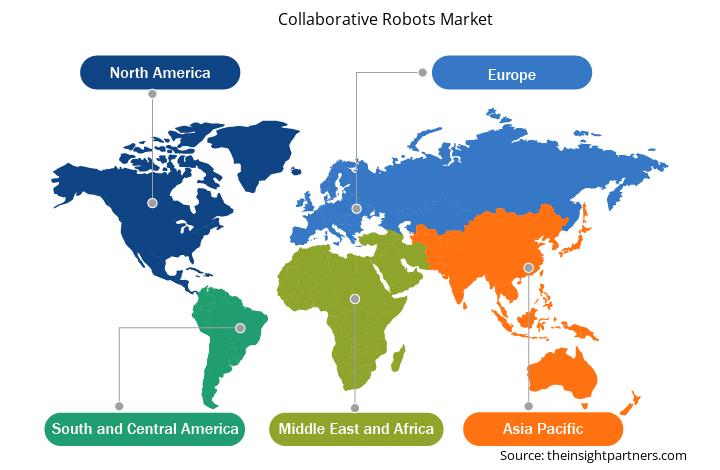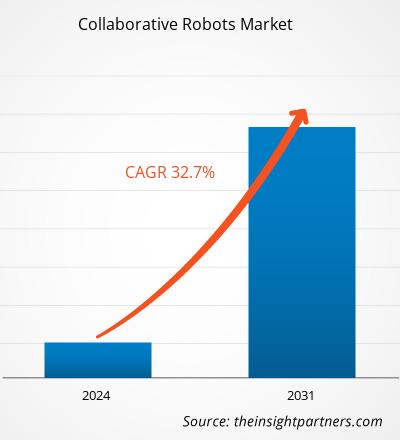協働ロボット市場規模は、2024年の18億8,000万米ドルから2031年には146億7,000万米ドルに達すると予測されています。市場は2025年から2031年にかけて35.7%の年平均成長率(CAGR)を記録すると予想されています。モバイル型協働ロボットは、市場に新たなトレンドをもたらす可能性が高いでしょう。
協働ロボット市場分析
協働ロボットは、マテリアルハンドリング、製造、研究室などで利用されるサービスロボットの一種です。工場、特に人間とロボットが既に協調して作業を始めている製造業における需要の高まりが、協働ロボット市場の成長につながっています。協働ロボットの登場により、人間がロボットと安全に共存できる、信頼性の高い作業環境が実現しました。市場を牽引する主な要因としては、ロボットの開発と導入に対する政府の支援、そして製造業の急速な拡大などが挙げられます。
協働ロボット市場の概要
産業界は、協働ロボットの台頭を主な原動力として、大きな変革期を迎えています。先進的な機械は、人間と共に安全かつ効率的に作業できるよう設計されています。これらのロボットは、安全性、生産性、そして持続可能な操業を支えるインテリジェントなチームメイトへと進化しています。人間と同等の速度で動作する協働ロボットは、動作に関連するリスク評価を簡素化し、近くの作業員が意図しない接触を回避しやすくなります。
世界各国の政府は、自国におけるロボット工学の開発と導入を支援・促進するための取り組みを進めています。こうした政府の取り組みや施策は、産業用ロボット市場の成長を世界的に促進し、ひいては協働ロボットの需要も押し上げると予想されます。2022年には、ヨーロッパが世界の協働ロボット市場で最大の収益シェアを占めました。ヨーロッパでは、堅調な自動車セクターと大手高級車メーカーの存在が、協働ロボット市場を牽引すると予想されます。さらに、電気自動車製造の成長も、協働ロボット市場の成長を牽引すると予想されます。
このレポートの一部、国レベルの分析、Excelデータパックなど、あらゆるレポートを無料でカスタマイズできます。また、スタートアップや大学向けのお得なオファーや割引もご利用いただけます。
協働ロボット市場:戦略的洞察

-
このレポートの主要な市場動向を入手してください。この無料サンプルには、市場動向から見積もりや予測に至るまでのデータ分析が含まれます。
協働ロボット市場の推進要因と機会
ロボットの開発と導入に対する政府の支援
世界各国の政府は、自国におけるロボット工学の開発と導入を支援・促進するための取り組みを進めています。例えば、シンガポール政府は、産業変革プログラムの一環として、イノベーション、自動化、企業の拡大を促進し、資金調達を促進するための様々な措置を発表しました。インド政府は、生産連動インセンティブ(PLI)制度など、インドにおけるスマート製造業の促進に向けた様々な措置を講じています。インドにおける製造業の振興に向けた主要な政府施策として、PLI制度は2020年に開始され、自動車、医薬品、繊維、食品加工、白物家電など14のセクターを対象としています。さらに、中国政府は、国内製造業における産業用ロボットの導入を促進するための様々な措置を講じています。これには、ハイテク産業の発展を目的とした「中国製造2025」計画も含まれます。さらに、政府は中国の産業用ロボット部門の拡大を目指し、5ヵ年計画の「ロボット産業発展計画」を発表しました。政府は、産業自動化に対して多額の補助金と税制優遇措置を提供しています。さらに、ドイツのインダストリー4.0イニシアチブには、産業用ロボットの開発と導入が含まれています。政府は、2016年から2020年にかけて、研究機関、企業、学術機関に対し、人間とテクノロジーのインタラクションに関する研究を支援するため、毎年約7,800万米ドルの返還不要の現金助成金を提供することを発表しました。現在、政府は自動化とロボット工学に関連する約300の研究プログラムを提供しています。
韓国政府は、270万米ドル規模の投資計画「第2次知能ロボット開発基本計画(2014~2018年)」を発表しました。第2次基本計画(2014~2018年)終了後、政府は第3次知能ロボット基本計画(2019~2023年)を策定し、実施しました。
製造業の急速な拡大
近年、産業環境は飛躍的に進化しており、協働ロボットが大きな変化を牽引する役割を果たしています。従来のロボットとは異なり、協働ロボットは人間と共存するように設計されており、プログラミングには通常、人間の協力を必要とする安全対策が組み込まれているため、単独での運用は制限されます。しかしながら、協働ロボットは生産性を大幅に向上させるだけでなく、職場の安全性を向上させ、より柔軟で費用対効果の高い運用を可能にします。協働ロボットは現代の産業において不可欠な要素となり、製造業だけでなく、物流施設や医療施設など、世界中の様々な分野で活躍の場を広げています。
製造業において、協働ロボットは組立、溶接、マシンテンディング、梱包・パレタイジングなどの作業に広く活用されています。反復作業や精密作業を可能にする協働ロボットは、製品品質の向上と従業員の疲労軽減に貢献します。協働ロボットは定型作業を自動化することで、作業員がより価値の高い業務に集中できるよう支援し、最終的には製造工程全体の生産性、効率性、そして職場の安全性向上に貢献します。世界の製造業は急速に拡大しており、新たな地域が製造工場への投資を進めています。こうした拡大は、工場の生産性向上、顧客との優位性の維持、そして競争優位性の獲得に向けた技術革新を促進しています。このように、製造業の急速な拡大は、協働ロボットの世界的な需要を牽引しています。
協働ロボット市場レポート:セグメンテーション分析
協働ロボット市場分析の導出に貢献した主なセグメントは、ペイロード、アプリケーション、タイプ、エンドユーザー業界、および機能です。
- 積載量に基づいて、市場は5~10kg、5kg以下、10kg超に分類されます。2024年には、5~10kgセグメントが最大の市場シェアを占めました。
- 用途別に見ると、市場は組立、ピックアンドプレース、マテリアルハンドリング、品質試験、マシンテンディング、溶接、梱包、その他に分類されます。組立分野は2024年に最大の市場シェアを占めました。
- タイプ別に見ると、市場はロボットアーム、溶接ガン、グリッパー、その他に分類されます。ロボットアームセグメントは2024年に最大の市場シェアを占めました。
- エンドユーザー産業別に見ると、市場は自動車、電子機器、金属・機械、食品・飲料、物流、医薬品、その他に分類されています。2024年には自動車分野が市場を席巻しました。
- 機能別に見ると、市場は静止型ロボットと移動型ロボットに分かれており、2024年には静止型ロボットが市場を席巻しました。
協働ロボット市場シェア分析(地域別)
協働ロボット市場レポートの地理的範囲は、主に北米、アジア太平洋、ヨーロッパ、中東およびアフリカ、南米および中米の 5 つの地域に分かれています。
2024年、アジア太平洋地域は協働ロボット市場で大きなシェアを占めました。アジア太平洋地域には、製造業の著しい成長を遂げている多くの発展途上国があり、多様な製造業が集積する世界的な製造拠点となっています。中国が高技能製造業の中心地へと変貌を遂げる一方で、インド、韓国、台湾、ベトナムといった新興国は、低技能から中技能の製造拠点の移転先を探している企業をますます惹きつけています。これらの国々は競争力のある人件費を提供し、政府の支援策を通じて積極的に外国直接投資を促進しています。しかし、地域における主要な製造拠点としての地位を確固たるものにするためには、これらの国々は熟練労働者の不足、生産性の低さ、インフラの未整備といった課題に対処する必要があります。
アジア太平洋地域の発展途上国政府は、製造業が自国に工場を設立できるよう、税制優遇、基金、補助金などの支援策を提供しています。さらに、多くの政府は「中国製造2025」や「インド製造」といった政策を実施しています。しかし、最大の製造拠点である中国は、高齢化の進展に伴い人件費が上昇しています。そのため、製造業は東南アジア諸国への投資を模索しています。インフラ整備、国内消費の増加、そして低コストは、製造業がこれらの国々に進出する要因として挙げられます。
中国は世界最大の乗用車生産国です。アジア太平洋地域には、日本、インド、韓国といった主要自動車生産国が存在します。自動車産業以外にも、中国では様々な産業で協働ロボットが導入されています。例えば、中国最大級の浴室アクセサリーメーカーである厦門ランナー工業株式会社では、ユニバーサルロボット製のロボット64台が生産ラインに導入され、成形機のテンディングや製品組み立てなど、様々な作業に活用されています。
協働ロボット市場の地域別分析
Insight Partnersのアナリストは、予測期間を通じて協働ロボット市場に影響を与える地域的なトレンドと要因を詳細に解説しています。このセクションでは、北米、ヨーロッパ、アジア太平洋、中東・アフリカ、中南米における協働ロボット市場のセグメントと地域についても解説します。

- 協働ロボット市場の地域別データを入手
協働ロボット市場レポートの範囲
| レポート属性 | 詳細 |
|---|---|
| 2025年の市場規模 | 18億8000万米ドル |
| 2031年までの市場規模 | 146億7000万米ドル |
| 世界のCAGR(2025年~2031年) | 35.7% |
| 履歴データ | 2021-2023 |
| 予測期間 | 2025~2031年 |
| 対象セグメント |
ペイロード別
|
| 対象地域と国 |
北米
|
| 市場リーダーと主要企業の概要 |
|
協働ロボット市場のプレーヤー密度:ビジネスダイナミクスへの影響を理解する
協働ロボット市場は、消費者の嗜好の変化、技術の進歩、製品メリットへの認知度の向上といった要因によるエンドユーザーの需要増加に牽引され、急速に成長しています。需要の増加に伴い、企業は製品ラインナップの拡充、消費者ニーズへの対応のためのイノベーション、そして新たなトレンドの活用を進めており、これが市場の成長をさらに加速させています。
市場プレーヤー密度とは、特定の市場または業界内で事業を展開する企業または会社の分布を指します。これは、特定の市場空間における競合企業(市場プレーヤー)の数が、その市場規模または市場価値全体と比較してどれだけ多いかを示します。
協働ロボット市場で事業を展開している主要企業は次のとおりです。
- クーカAG
- 安川電機アメリカ株式会社
- Aubo(北京)ロボティクステクノロジー株式会社
- 斗山ロボティクス株式会社
- ファナック株式会社
- ABB株式会社
免責事項:上記の企業は、特定の順序でランク付けされているわけではありません。

- 協働ロボット市場のトップキープレーヤーの概要を入手
協働ロボット市場のニュースと最近の動向
協働ロボット市場は、主要な企業出版物、協会データ、データベースなどを含む一次調査および二次調査を経て、定性・定量データを収集することで評価されます。協働ロボット市場における動向のいくつかを以下に示します。
- オムロンは、多様な産業分野における多様な用途向けに設計された協働ロボット「OMRON TM Sシリーズ」の発売を発表しました。これらの協働ロボットは、高度なハードウェア、より多くの安全機能と認証、そして次世代の設定機能を導入し、これまで以上に使いやすくなっています。(出典:オムロン、プレスリリース、2024年9月)
- 国際的に有数の独立系第三者試験・検査・認証機関であるTÜV Rheinland Groupは、ESTUN Automation Co., Ltd.に対し、ESS(ESTUN Safety Solution)製品に対するCE機械指令および機能安全適合証明書を発行しました。これは、ESTUNが包括的なロボット機能安全製品システムの構築において急速に進歩を遂げたことを示しています。この認証は、ESTUNのロボット技術分野における革新力と専門性の高さを示すだけでなく、製品の安全性と品質に対する厳格な管理とコミットメントを反映しており、グローバル市場におけるESTUNのサービス品質と効率性をさらに向上させるでしょう。(出典:ESTUN Robotics、プレスリリース、2024年4月)
協働ロボット市場レポートの対象範囲と成果物
「協働ロボット市場規模と予測(2021〜2031年)」レポートでは、以下の分野を網羅した市場の詳細な分析を提供しています。
- 協働ロボット市場規模と予測(世界、地域、国レベル)
- 協働ロボット市場の動向、および推進要因、制約、主要な機会などの市場動向
- 詳細なPEST分析とSWOT分析
- 主要な市場動向、世界および地域の枠組み、主要プレーヤー、規制、最近の市場動向を網羅した協働ロボット市場分析
- 協働ロボット市場の市場集中、ヒートマップ分析、主要プレーヤー、最近の動向を網羅した業界の展望と競争分析
- 詳細な企業プロフィール
- 過去2年間の分析、基準年、CAGRによる予測(7年間)
- PEST分析とSWOT分析
- 市場規模価値/数量 - 世界、地域、国
- 業界と競争環境
- Excel データセット
最新レポート
お客様の声
購入理由
- 情報に基づいた意思決定
- 市場動向の理解
- 競合分析
- 顧客インサイト
- 市場予測
- リスク軽減
- 戦略計画
- 投資の正当性
- 新興市場の特定
- マーケティング戦略の強化
- 業務効率の向上
- 規制動向への対応






















 無料サンプルを入手 - 協働ロボット市場
無料サンプルを入手 - 協働ロボット市場